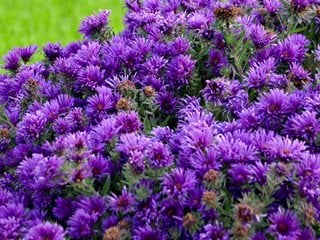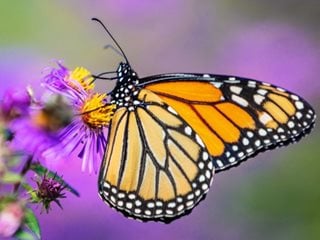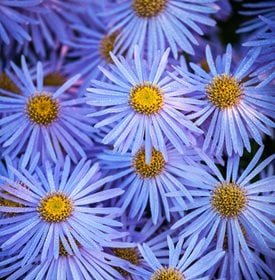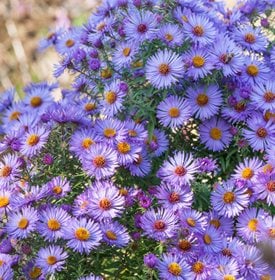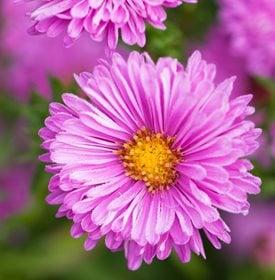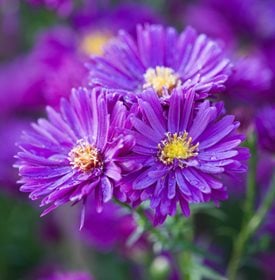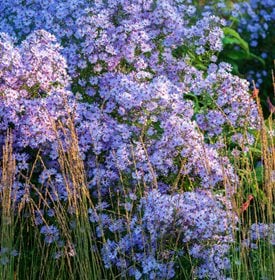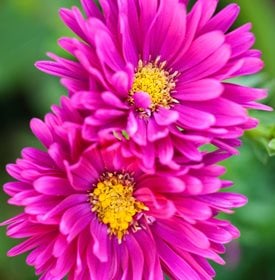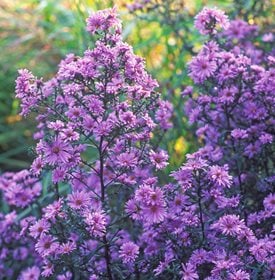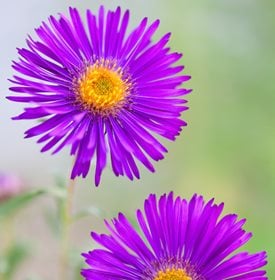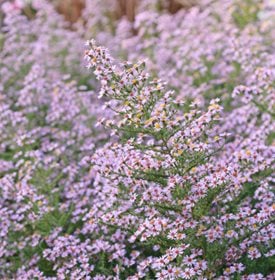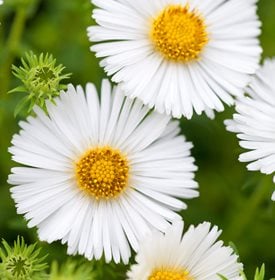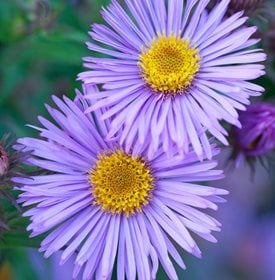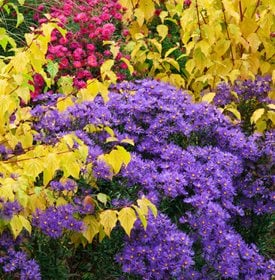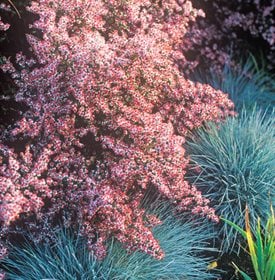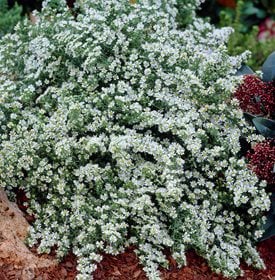Asters: Flowers for Perennial Fall Color
Learn how and where to plant 16 varieties in your garden.Asters are daisy-like flowers that bloom in late-summer and early-fall. They come in a wide variety of colors and sizes, are easy to grow and bloom predictably and reliably. They attract pollinators with their bright colors and are disease and deer resistant.
On this page: Basics | Planting | Care and Maintenance | Pictures | Design Ideas
On this page:
ASTER BASICS
Zones:
3-10; varies depending on species and cultivar.
Flower color:
Colors are diverse, ranging from white and pastel blues and pinks, to hybrids of deep scarlet and purple.
Bloom time:
August through October; varies depending on species and cultivar.
Height/spread:
Most range from 1 to 4 feet in height, with some growing as tall as 5 or 6 feet and some staying as small as 6 inches. Their width typically ranges from 1 to 3 feet.
Types:
According to the Chicago Botanic Garden, there are approximately 250 types, many of which are native to North America.
Here is a list of the most common garden asters:
- New England (Symphyotrichum novae-angliae)
- New York (Symphyotrichum novi-belgii)
- Aromatic (Symphyotrichum oblongifolium)
- Heath (Symphyotrichum ericoides)
- Smooth (Symphyotrichum leave)
- Calico (Symphyotrichum lateriflorum)
- Wood (Eurybia divaricata)
Other, less common, types include alpine, California, tatarian, heart-leaved, big leaf, sea, short’s, crooked-stem, Frikart’s, Italian, and East Indies. China aster (Callistephus chinensis), which belongs to the same plant family discussed here, is actually an annual.
PLANTING ASTERS
When:
Asters can be planted anytime from spring through fall. In warm areas, avoid planting during the heat of the summer. In cool areas, plant no later than early fall so the roots have time to develop before freezing temperatures arrive.
Soil:
All types of soil, but most prefer well-drained, organically rich soil. Learn more about preparing your soil here: Garden Soil 101.
Exposure:
Full sun, tolerates light shade, likes cooler summer temperatures.
Spacing:
Depending on which ones you're planting, they’ll need to be spaced 1 to 4 feet apart.
Containers:
They can be planted in containers using a lightweight potting mix. Make sure your pot has a drainage hole and that there is easy access to water nearby. Some people even grow potted asters indoors.
ASTER CARE
Water:
Once established, they require little watering, unless conditions have become unusually dry and the plants show signs of stress. New York aster (Symphyotrichum novi-belgii) cultivars have shallow roots and may need more frequent watering during the summer, especially when planted in free-draining soils. Keep soil moist, but not saturated. Mulching to reduce water loss is an important strategy for preventing disease.
Pruning:
Pinching back stems, or deadheading, several times before mid-July helps to control plant height, promote bushiness, and encourages blooming through the entire season. Leave a few wilted blooms at the end of the season if you want them to self-sow. Learn more about pinching and deadheading here: Pruning Garden Shrubs and Perennials.
Staking:
Taller stemmed varieties may require staking.
Fertilizing:
Some gardeners say a layer of organic mulch will supply all the nutrients they need, while others suggest a light application of an organic fertilizer at the start of their growing season. Do not apply fertilizer once they have started blooming as it may shorten the bloom time.
Dividing:
Whether you’re dividing to control the size or to propagate them, do it in spring just as new shoots are emerging. This will give them the entire growing season to overcome the shock. The frequency of division varies depending on the species and cultivar, but most will benefit from division every 2 to 4 years.
Pests and diseases:
In some areas foliar rust and powdery mildew can be a problem, while lace bugs pose the biggest threat when it comes to pest damage.
ASTER PICTURES
With such variety, it is easy to see why these autumn-blooming perennials take center stage in so many gardens. Here are a few varieties to explore:
EXPERT DESIGN TIPS
Choose Contrasting Companions
Hardy ornamental grasses and substantial foliage plants such as Yucca, Carex, and coleus provide a sturdy backdrop for softer or brightly colored asters. For Jim Sutton of Longwood Gardens, his favorite sustainable companion plant is kale—especially ‘Lacinato’.
Go Big
Paul Picton, co-author of The Plant Lover’s Guide to Asters, says, “When planted en masse, billowing clouds of color will enhance and revive gardens at a time of year when most other flowers are fading.”
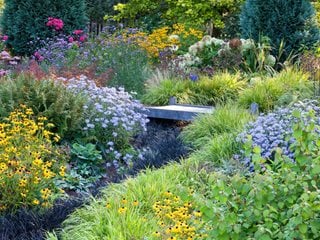
Planting asters alongside late-blooming perennials and grasses with strong color brings the autumn garden to life. Here, Aster ×frikartii ‘Mönch’ is joined by Rudbeckia fulgida ‘Viette’s Little Suzy’, Rudbeckia subtomentosa, Hydrangea ‘Annabelle’, Verbena bonariensis, Sedum ‘Matrona’, and Rosa ‘Rosemary Rose’, sweeps of Japanese forest grass, and black mondo grass. Photo by: Richard Bloom.
Put Them in a Container
Use a single bushy plant, or create a mini-landscape with smaller asters and grasses. Picton suggests cultivars, Symphyotrichum ericoides ‘Golden Spray’, and S. novi-belgii ‘Lady in Blue’ or ‘Rosebud’.
Pump Up the Color
Place them next to other fall-flowering perennials, bulbs, and shrubs—or more asters. Mr. Picton recommends yellow and says goldenrods make wonderful companions.
Vary Heights
Plant a mix of tall upright stems, low spreading shrubs, and everything in between. Used as a mid-border plant, medium-to-tall asters will pop out after the summer blooms have gone off. “Come September, they get a chance to shine,” Sutton says.
Place Properly
“Asters from Symphyotrichum novi-belgii, S. novae-angliae, S. ericoides, and S. cordifolium are happy in an open, sunny site in soil that doesn’t get too dry in summer,” Mr. Picton says. “Other species such as Eurybia schreberi will be happy to grow in dry shade. Warmer conditions might be tolerated by some of the true asters found wild in Europe and Asia.”
Whether you want a pop of late-season color or an addition to your pollinator garden, asters could be the answer.
Portions of this article were adapted from a piece originally written by Meg Ryan for Garden Design Magazine.
Last updated: April 4, 2024
RELATED:
Ageratum - How to Grow and Care for Floss Flower
20 Common Plants Safe for Cats & Dogs
24 Purple Flowers to Brighten Your Garden
20 Drought-Tolerant Plants for Your Garden
Fall Flowers
